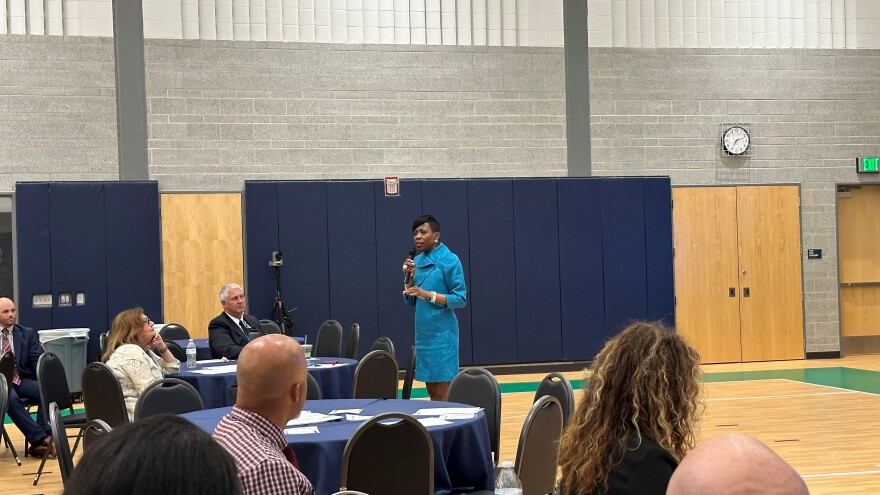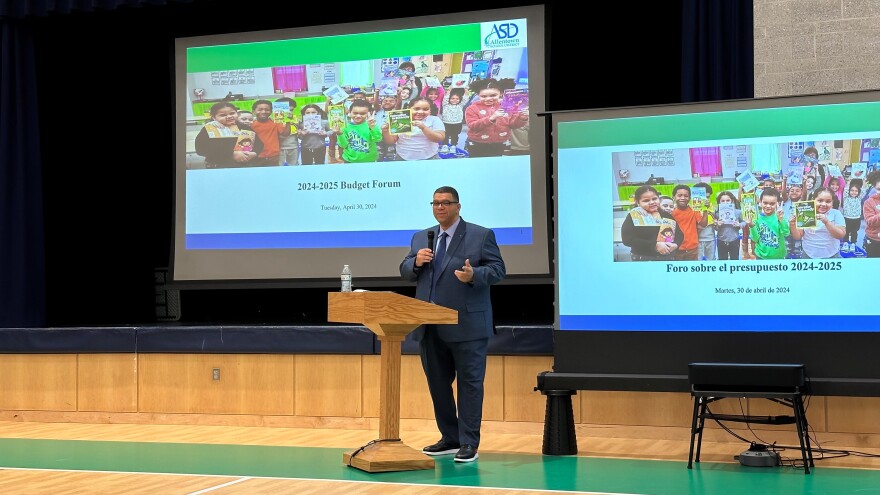ALLENTOWN, Pa. — Allentown School District on Tuesday welcomed the community back to the classroom for a session on next year’s budget — which may arrive without a tax increase.
To make sense of the complex nature of school budgets, ASD set up the special meeting at Hays Elementary School to examine where funding comes from, where it goes and what role the district plays in the process of allocating the money.
Before diving into an intense lesson in finances, Chief Outreach Officer for Family and Community Engagement Robin T. Harris warmed up the room with a round of Budget Bingo, with cards featuring common terms.
Following a quick and entertaining break for a student performance of a duet from the musical play "Cabaret" by two Dieruff High School students, Superintendent Dr. Carol D. Birks addressed the crowd.
One of the standout elements of the presentation focused on how the district had managed to maintain a stable tax rate, with no expected increase for residents next year.
But amidst that news, attendees got a refresher course in budgeting.
“A part of my job is to help, along with the school board of directors, to maintain our budget and to be responsible for the $460 million that we had this year,” Birks said.
“And we have 430-something million dollars when people think about they say, ‘That’s a lot of money.’ But we're going to explain tonight, in basic terms, how those resources are spent.”
Budget basics and revenue streams
Interim district Chief Financial Officer Jeffrey Cuff jumped into his “School Budget 101” presentation with a quick overview of the district’s core mission values and student and staff makeup before spelling out budget goals.
Focal points included increasing student achievement in reading and math, decreasing chronic absenteeism and increasing graduation rates.
Also, increasing language acquisition for English Language Learners, aligning priorities from the district’s Strategic Planning Process, and creating multiple pathways and theme-based schools.
Taking a peek at breakdowns with other districts, Cuff pointed out Allentown counts 16,195 pupils with a 76.96% poverty rate — meaning most of the funding, 54.08%, comes from the state. Local revenue accounts for 30%.
Expenses per student in ASD sit just below the average of the districts in the Lehigh Valley — $22,026 per pupil.
Cuff noted revenue for the district comes from three main sources: local taxes, state subsidies and federal funding.
In ASD, that amounts to $123,789,665 from local revenue, $291,562,302 from the state and $21,476,785 from the federal government, totaling $436,828,752 for the current 2024-25 district budget.
Local revenue comes from real estate taxes, both current and delinquent, Act 511 School District Taxes, and interest, donations and rentals.
Local real estate revenue for 2023-24 hit a high point in past few years, at $99,371,159.
But for next school year, the budget is looking at a local increase with a proposed $103,917,159 coming from local real estate alone. Along with other revenue streams, the total local revenue for 2024-25 will likely see an increase of nearly $900,000 over last year.
“So as we look forward to next year and to our '24-'25 budget, you'll see that right now we're budgeting to keep our real estate taxes consistent with where we are this year for '23-'24,” Cuff said.
As Cuff explained, state revenue stems from Basic Education Funding — perhaps the biggest piece of the puzzle — alongside FICA reimbursement, special education funding, transportation subsidies, and pension reimbursement.
Gov. Josh Shapiro has proposed a $1.1 billion increase in the Basic Education Funding — with the bulk, around $872 million, going to a “first-year adequacy investment.”
Also, $50 million each for special education and safety and security measures, and $100 million for school mental health support grants.
Shapiro’s budget would see ASD's state increase $36,422,253 from Basic Education Funding, Special Education Funding, and Ready to Learn block grants.
On the federal side, revenues are currently listed at $21,476,785, the same rate seen in the 2023-24 budget for the district.

Cuff sai the district is playing it safe with assumptions until Shapiro’s budget is finalized soon.
“We’ve got to be very conservative in our approach because we know that there will be a lot of discussion up in Harrisburg, a lot of going back and forth,” Cuff said.
Expenditures and success stories
Next up, Cuff dove into a discussion on where all that money goes: instruction, support services, non-instructional services, facility acquisitions, construction, improvements and financing debt services.
“You'll see here, the major difference here between those two years, this is a snapshot of what our revenues and expenditures were for last year, versus this year," Cuff said.
"he major differences will be because of extra spending.”
He said Elementary and Secondary School Emergency Relief funds rom the COVID-19 pandemic must be spent, or at the very least allocated, by the end of this year.
ASD’s 2024-25 budget sees the bulk of its expenses in instruction, with $144,203,287 allocated to salaries and $99,176,115 for benefits.
Additional significant line items include more than $73 million in tuition charter school funding, more than $31 million in debt service and more than r $24 million for professional services.
All told, the expenditure summary syncs up with the revenue summary for a total of $436,828,752, with no surplus or deficit, a more than $15.5 million drop from the 2023-24 budget.
Simply seeing numbers on a spreadsheet may not resonate with taxpayers, though, so Birks took to the microphone again to touch upon some of this year’s school success stories in pre-kindergarten programs, on-demand tutoring, mental health support, increased student enrollment, better strategic planning, and the premier of the district’s Stream Academy.
Other celebratory notes included a 14% increase in total meals provided for students — more than 3 million as opposed to 2.6 million last school year.
Cost drivers
Notable increases were detailed in certain fields, with charter school costs up 3.7%, salaries going up 4% and benefits costs increasing 10%.
But the biggest cost driver for 2024-25, at least in terms of percentages, will be transportation, with an estimated 30% increase over this year’s rates.
That's because this is the first time increase in half a decade, since signed a new contract with Student Transportation of America.
As it stands, 2,482 ASD students and 2,830 charter students ride buses to school.
“A good portion of those children do walk, but there are those who require transportation, either because of the distance or because of physical needs," Cuff said. "So there is transportation needed.
"Any service that we provide for our students for transportation, we are by state law required also to provide the same transportation for charter school kids or nonpublic students.”
ASD will look to have its highest fund balance in years — more than $31.6 million as of 2022’s statistics.
Much work remains. Cuff said the district’s Board Finance Committee will hold a preliminary final budget discussion on May 9, 2024, followed by a board vote on that budget on May 23, another discussion on June 13, and adoption on June 27.
The budget presentation soon will be made available in the district’s online newsletter, and potentially in other formats.
Armed with plenty of knowledge on the process — and a printout of budget terms provided at Tuesday’s presentation — taxpayers in the district should be ready for those upcoming meetings.
Fortunately, there won’t be a test after everything is said and done, though the public will surely be more well-informed about the process of budgeting in a school district.


